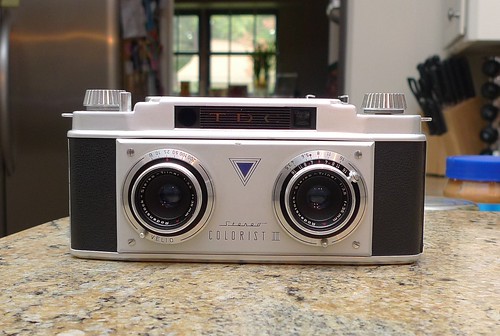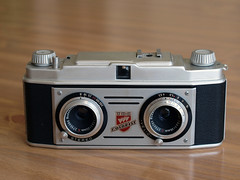Difference between revisions of "TDC Stereo Colorist"
m (Retracing my steps a bit.. Undo revision 133354 by Dustin McAmera (talk)) |
(Commented out explanation of stereoscopy; reordered a couple of other sentences; added wikilink to B&H. Changed 'Stereo Colorist I to Stereo colorist') |
||
| Line 26: | Line 26: | ||
| − | The TDC Stereo Colorist was introduced in 1954 as a competitor in the stereo market to the popular [[Stereo Realist]]. | + | The TDC '''Stereo Colorist''' was introduced in 1954 as a competitor in the stereo market to the popular [[Stereo Realist]]. |
| − | + | Both the Stereo Colorist and the Stereo Colorist II were made in the 1950s in Germany by Bodensee Kamerawerke for Three Dimension Company, a subsidiary of [[Bell & Howell]]. | |
| − | |||
| − | |||
| − | Both the Stereo Colorist | ||
They are designed to use 35mm color reversal (slide) film. The format of the picture is the 5p (five perforations of 35mm film) that was used in the Stereo Realist. | They are designed to use 35mm color reversal (slide) film. The format of the picture is the 5p (five perforations of 35mm film) that was used in the Stereo Realist. | ||
| − | While the | + | While the Stereo Colorist is scale focusing, the Stereo Colorist II has an integrated rangefinder. Otherwise they are the same. They both have three-element [[Rodenstock]] 35mm f/3.5 Trinar lenses. |
| + | <!-- commenting this out; if we are to have an explanation of stereoscopy, it deserves its own paghe; we can't have it on every page about a stereo camera; but others may disagree. | ||
== Stereoscopy == | == Stereoscopy == | ||
| − | |||
The stereo camera creates a 3D effect by taking two pictures simulataneously at eye width apart. When the two pictures are viewed in a designated holder which forces the each eye to view the respective slide individually, a 3D effect is simulated. | The stereo camera creates a 3D effect by taking two pictures simulataneously at eye width apart. When the two pictures are viewed in a designated holder which forces the each eye to view the respective slide individually, a 3D effect is simulated. | ||
| − | + | --> | |
{{Flickr_image | {{Flickr_image | ||
| Line 51: | Line 48: | ||
}} | }} | ||
| − | <br | + | <br style="clear:right;"/> |
| + | |||
| + | ==Links== | ||
| + | * [http://www.stereoscopy.com/cameras/tdc-colorist-2.html TDC Stereo Colorist] at ''[http://www.stereoscopy.com/ Welt der Stereoskopie] | ||
| + | * [http://photosttl.blogspot.com/2010/10/tdc-stereo-colorist-ii-review.html TDC Stereo Colorist II review] at | ||
| − | |||
| − | |||
| − | |||
| − | |||
[[Category: German stereo]] | [[Category: German stereo]] | ||
Revision as of 19:31, 28 June 2012
| TDC Stereo Colorist |
|---|
|
Date of Production: 1954
Film type: 35mm
|
The TDC Stereo Colorist was introduced in 1954 as a competitor in the stereo market to the popular Stereo Realist.
Both the Stereo Colorist and the Stereo Colorist II were made in the 1950s in Germany by Bodensee Kamerawerke for Three Dimension Company, a subsidiary of Bell & Howell.
They are designed to use 35mm color reversal (slide) film. The format of the picture is the 5p (five perforations of 35mm film) that was used in the Stereo Realist.
While the Stereo Colorist is scale focusing, the Stereo Colorist II has an integrated rangefinder. Otherwise they are the same. They both have three-element Rodenstock 35mm f/3.5 Trinar lenses.

|
| TDC Stereo Colorist II image by chris00nj (Image rights) |
